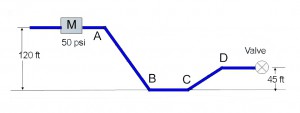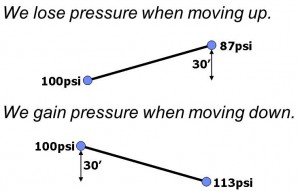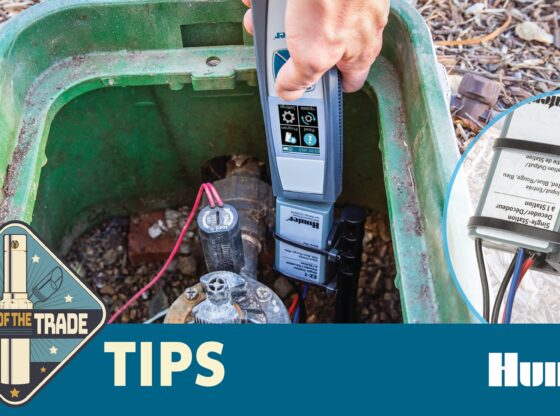Energy is required to move water in a pressurized irrigation pipeline. More energy is required when moving water uphill. Gravity has to be overcome!
But, gravity can also cause more energy to be available when moving water downhill. The net effect is a change in operating pressure along the irrigation pipeline because of elevation changes. Elevation changes may have minor impact on pressure when laying a pipeline on flat terrain. We may have to account for pressure being too high and too low all on the same pipeline when dealing with large elevation changes!
When calculating pressure changes due to elevation we need to know the vertical elevation change in feet. Length of the pipe run does not matter for elevation, but it sure does for friction pressure loss calculations. See the example layout below;
In the first case, we start with 100 psi and move water to point B, which is 30’ higher than point A. To find out how much pressure will be left after the elevation change, multiply the elevation change by the factor .433.
30’ x 0.433 = 12.99 psi loss.
Thus our beginning pressure of 100 psi minus our loss of 12.99 psi means we have 87.01 psi left.
100 psi – 12.99 psi = 87.01 psi
This does not include pressure losses due to friction! In fact, we lose 12.99 psi whether the water is flowing or not. To figure exactly how much pressure is left during operation you will have to also calculate the friction losses.
In the second example we are flowing downhill. The result is just the opposite, we gain 12.99 psi. So now we have 112.9 psi at point B.
Where does the factor 0.433 come from? That is how much pressure is created per foot of elevation. Basically, the weight of water on itself. Picture a water tower that is 100’ from the surface of the water in the tank to the ground. That represents an elevation of 100’, or 100’ Feet of Head, as the pump guys would talk. To covert Feet of Head to pressure, multiply the feet by 0.433.
What happens when we have a large elevation increase? We could run out of energy (pressure) to get the irrigation job done. Our options are limited. It probably means we must add a booster pump to add more pressure.
What happens when we have a large elevation decrease? We gain a bunch of pressure and may need to reduce it so as not to blow fittings. In that case we can use pressure regulating devices. We may need to use heavier pipe and fittings too.
Sometimes there is a large change both up and down. In such cases, just figure the actual elevation change from point A to point B. See below;
In this case we drop 120’ from point A but then rise 45’ to get to point D. The difference between A and D is 120’-45’ or 75’. Because we are going downhill to point D, we gain pressure. So take our 75’ in elevation change and multiply it by 0.433 which tells us we gain 32.475 psi.
75’ x 0.433 = 32.475 psi gain
To determine expected pressure at point D, add the 32.475 gain to the beginning pressure, which in this case was 50 psi.
32.475 psi gain + 50 psi = 82.475 psi.
Again, this is the effect of pressure due to elevation change only. We still need to add in the effects of friction losses when running water.












